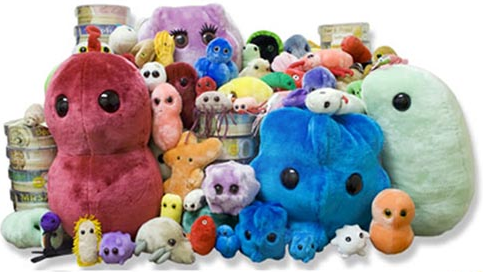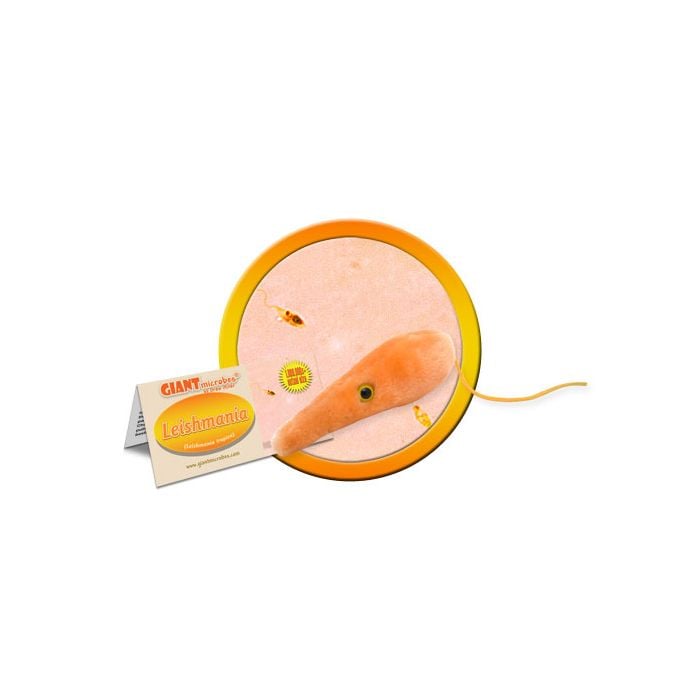Leishmania (Leishmania tropica)
Out of Stock
Product Details
Additional Information
| Sizes | Giantmicrobes are based on actual microbes, cells, organisms and other critters, only 1,000,000 times actual size! Gigantic (GG) 16-24" XL (XL) 10-15" Original (PD) 5-8" Keychain (KC) 2-4" with clip |
|---|---|
| Materials | Plush from all new materials. Stuffed with polyester fiber fill. Surface washable: sponge with water & soap, air dry. |
| Packaging | Each plush microbe includes a printed card with fun, educational and fascinating facts about the actual microbe or cell. |
| Safety | Every product meets or exceeds U.S. and European standards for safety. For ages 3 and up. |
All about Leishmania (Leishmania tropica)
FACTS: Leishmania tropica is a tropical parasite that is primarily transmitted to humans by the bite of the sandfly. It is found in most tropical and sub-tropical countries around the world.
The most common manifestation of a leishmania infection is cutaneous leishmaniasis. It typically consists of a large skin sore originating near the site of the initial sandfly bite – though additional sores can also spread around the body. These sores can change size and appearance as they develop, but they often appear crater-like with raised edges. When the sores form in the soft tissues of the nose and mouth, severe damage and disfigurement can result.
A less common, but even more serious, form of leishmania infection is visceral leishmaniasis – or kala-azar, meaning Black Fever in Hindi. This manifestation is internal, and a greatly enlarged spleen and liver is one of the primary hallmarks of the disease, as well as fever, fatigue, and anemia.
In fact, it was while examining smears from an enlarged spleen that Scottish pathologist William Bogg Leishman first observed the parasite responsible for the disease in 1901. However, because Charles Donovan made a similar discovery before Leishman published his findings in 1903, the name Leishmania donovani was bestowed upon the kala-azar-causing creature to honor them both.
| Name | Leishmaniasis is caused by the genus, Leishmania, the sand flies that cause the disease. |
|---|
| Where It Lives | The disease is spread by the bite of phlebotomine sand flies. There are multiple forms; the most common being cutaneous leishmaniasis, which causes skin sores, and visceral leishmaniasis, which can affect internal organs such as the spleen, liver, and bone marrow. |
|---|
| Symptoms | With cutaneous leishmaniasis, the sores typically develop within a few weeks or months of the sand fly bite. The sores can present as bumps or lumps and can end up as ulcers. For those with visceral leishmaniasis, the illness typically develops within months (sometimes as long as years) of the sand fly bite. Affected people usually have fever, weight loss, swelling of the spleen and liver, and low blood counts. |
|---|
| Cure | The skin sores of cutaneous leishmaniasis usually heal on their own, even without treatment. Supportive care for patients with visceral leishmaniasis, as required; this includes rest, a high-protein and high-calorie diet, blood transfusions, and wound care. |
|---|
| History |
1901: Identified by William Leishman Big Outbreaks: 1984-1994: Western Upper Nile State in South Sudan experienced a major outbreak of visceral leishmaniasis. 2004: 161 cases of cutaneous leishmaniasis caused by Leishmania tropica occurred in the Jerusalem district Recent Outbreaks: 2012: 948 persons diagnosed in Syria. |
|---|
| Fascinating Facts | For cutaneous leishmaniasis, the estimated number of cases is 700,000 to 1.2 million. For visceral leishmaniasis, the number of cases ranges from 200,000 to 400,000. |
|---|





